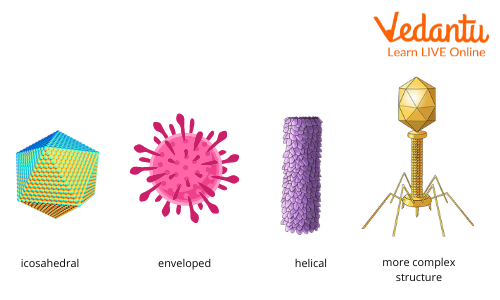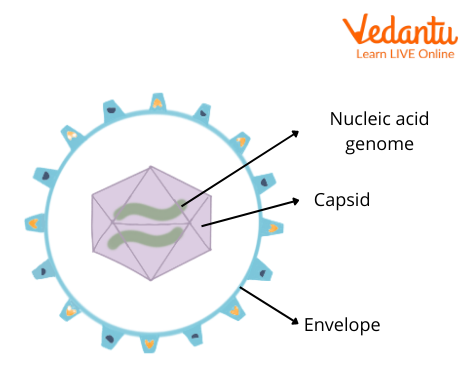




What are Viruses?
Recently we have suffered immensely because of the COVID 19 coronavirus. Wouldn't it be interesting to learn more about them and understand their characteristics? A simple definition of viruses for kids is that a virus is a tiny, contagious piece of matter that can only reproduce by infecting a host cell. There are many types of viruses too.

Types of Viruses
The virus "takes over" the host cell and uses its resources to make more viruses. The cell is reprogrammed to become a factory for viruses. Viruses are not alive because they can't reproduce on their own (without a host). Viruses don't have cells either. They are very small, much smaller than the cells of living things, and are mostly just packages of nucleic acid and protein.
Still, there are some important ways in which viruses are like cell-based life. For example, their nucleic acid genomes are made up of the same genetic code as your cells (and the cells of all living creatures). Also, just like living things made of cells, viruses have different genes and can change over time. Let us learn some interesting facts about viruses for kids.
Characteristics of Viruses
There are many different kinds of viruses out there. So, viruses vary in size, shape, and how long they live. There are, however, a few key things that all viruses have in common.

Structure of Virus
Capsid - It is a protective shell made of protein. It holds Nucleic materials.
Nucleic acid - A DNA or RNA nucleic acid genome is located within the capsid.
Envelope - The envelope is a thin layer of a membrane that houses all the materials of a virus cell.
As mentioned, viruses don't have organelles for making their own food. So, the question arises can viruses metabolise their food? The short answer is NO. They can not metabolise(breakdown) food to release energy. All they can do is replicate with their genetic material.
Viral Diseases
In ordinary life, we frequently associate a viral infection with the unpleasant symptoms we experience after contracting a virus like the flu or chickenpox. But what truly happens when you have a virus in your body? On a microscopic level, a viral infection indicates that several viruses are utilising your body cells to multiply. The process by which a virus recognizes and enters a host cell reprograms the host by supplying an instruction set of viral DNA or RNA and utilises the host's resources to make other virus particles is known as the viral life cycle.
As compared to normal cells, viruses are significantly tiny. In reality, viruses are essentially just genetically engineered capsules, without any mechanism to reproduce. To proliferate, viruses enter your body's cells and take control of the functional components of those cells. During this process, host cells are frequently eventually killed. Many illnesses are brought on by viruses like AIDS, Common cold, Ebola, Herpes, Influenza, Measles, Shingles, and chicken pox, 2019 Coronavirus disease (COVID-19). Viruses are unaffected by antibiotics made for bacteria.
Interesting Facts About Viruses
Since they lack cells, cannot convert food into energy, and are inert chemical packets without a host, viruses cannot be considered living organisms.
Viruses also have genes, may reproduce, and can change over time due to natural selection.
Wendell Stanley, an American biochemist, received a Nobel Prize in Chemistry in 1946 for purifying the tobacco mosaic virus into needle-like protein crystals. This was a victory for Team Nonliving.
The word "virus" is derived from the Latin for "poison" or "slimy liquid," which is a fitting description of the virus that causes the flu and the common cold.
In 1992, researchers looking for a pneumonia outbreak in England discovered a sizable new virus hiding within an amoeba in a cooling tower. They initially believed it to be a bacteria because it was so big and complicated.
It turns out that amoebas are excellent sources of novel viruses. They enjoy swallowing large objects and act as a gene-swapping platform for bacteria and viruses.
It is already known that viruses can infect bacteria, plants, mammals, fungus, protozoa, and archaea. They can also spread to other viruses.
Viral remnants may influence some malignancies and autoimmune illnesses in our genomes.
A few viral proteins are useful. For example, they might have prevented your mother's immune system from fighting you while you were still inside her.
Researchers are using the HTLV virus, which has coevolved with humans for thousands of years, to identify ancient migration patterns. The present distribution of it shows that thousands of years before Siberians ventured across the Bering Strait, Japanese seafarers were the first to reach the Americas.
Conclusion
Viruses are microscopic organisms that are inert and require another host cell to reproduce. They come in various forms. The basic structure of a virus contains a Neuclic acid, a Capsid, and an Envelope. When viruses infect our body cells to live there, they give rise to various viral diseases.
FAQs on Interesting Facts About Viruses for Kids
1. What distinguishes viruses from bacteria?
Although both bacteria and viruses can infect us, they differ greatly from one another biologically. Even though bacteria are tiny, single-celled organisms, they are living things that can multiply on their own without the help of a host cell. Viruses require a host cell to sustain them. Bacterial and viral illnesses are treated significantly differently due to these distinctions. For instance, viruses cannot be treated with antibiotics, only bacteria can. Viruses are treated with anti-viral medicines. It is recommended to take rest when suffering from viral diseases since viral diseases are also contagious.
2. Where did COVID-19 infections get their start?
In Wuhan, China, researchers found the first SARS CoV2 infections. It is still unknown how the virus first infected humans or whether it developed into a pathogen before or after the spillover incident.
3. What are the world's deadliest or most lethal viruses?
The world's worst viruses include Marburg, Ebola, Lassa, hantavirus, rabies, influenza, smallpox, and dengue.









